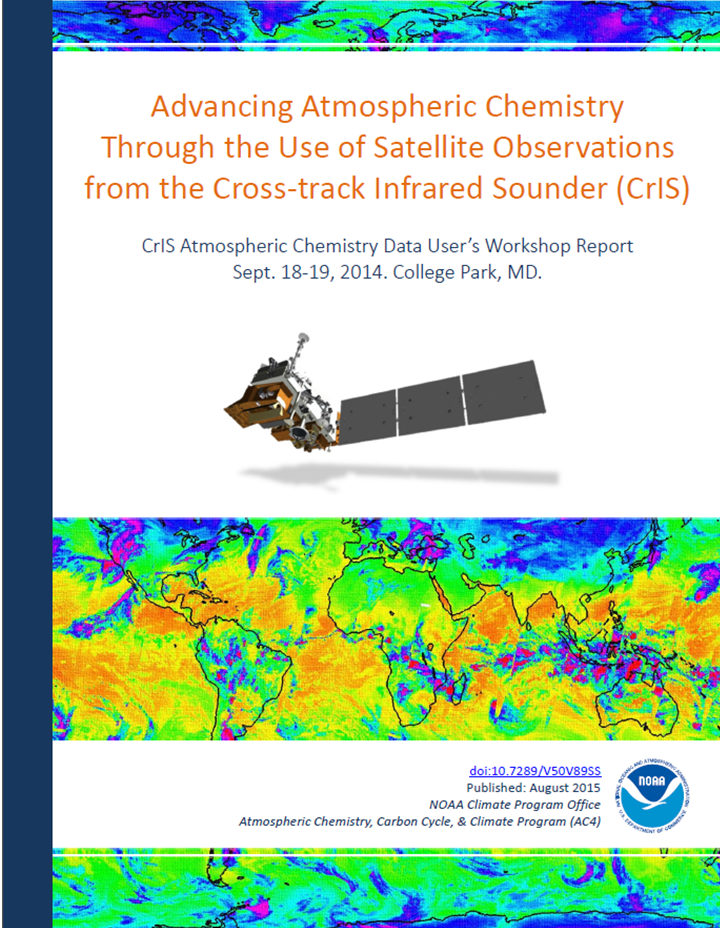
[ Archive ]

 |
CIMSS-NOAA Weekly Report
[ Archive ] |
 |
IN THE PRESS:
ITEMS FOR THE ADMINISTRATOR:
ITEMS FOR THE ASSISTANT ADMINISTRATOR:
ITEMS FOR THE OFFICE DIRECTOR, STAR:
CrIS Trace Gas Workshop Report Published: A report entitled “The Advancing Atmospheric Chemistry Through the Use of Satellite Observations from the Cross‐track Infrared Sounder (CrIS)” summarizing findings and recommendations from the CrIS Atmospheric Chemistry Data User’s Workshop (Sept. 18‐19, 2014. College Park, MD) was published by the NOAA Climate Program Office (CPO) Atmospheric Chemistry, Carbon Cycle, & Climate Program (AC4). The report is available online in the NOAA Library and Information Network Catalog (http://docs.lib.noaa.gov/noaa_documents/OAR/CPO/AC4/CrIS_workshop_2014.pdf). The report provides a summary of current user applications of thermal infrared trace gas retrievals, current and potential CrIS trace gas products, and CrIS trace gas validation requirements. The report authorship includes NOAA OAR, NESDIS, CPO, and Extramural representatives and is designed to ensure that CrIS can reach its full potential as an atmospheric composition instrument (R.B. Pierce, E/RA2, 608-890-1892, brad.pierce@noaa.gov)
 (Click image to enlarge)
(Click image to enlarge)
Figure caption: The Advancing Atmospheric Chemistry Through the Use of Satellite Observations from the Cross‐track Infrared Sounder (CrIS) Report Cover.
JPSS Science Team Meeting: STAR hosted the Annual Joint Polar Satellite System (JPSS) Science Team Meeting this week in College Park, Maryland. As algorithm leads, Jeff Key, Andrew Heidinger and Mike Pavolonis gave presentations on the status of and plans for their products and applications. During this meeting, it was announced that the JPSS-1 satellite will be named NOAA-20 once it becomes operational. Harry Cikanek, the head of the JPSS program, also reiterated his plans to fully implement the NOAA Enterprise algorithms for JPSS-1 and beyond. Liam Gumley, Chris Moeller, Robert Knuteson, Yinghui Liu and Yue Li (Cooperative Institute for Meteorological Satellite Studies / CIMSS) also participated the meeting. (A. Heidinger, E/RA2, 608-263-6757, andrew.heidinger@noaa.gov)
ITEMS FOR THE DIVISION CHIEF, CoRP:
More ABI Band Quick Information Sheets Developed: Several more Geostationary Operational Environmental Satellite (GOES) -R series Advanced Baseline Imager (ABI) band fact sheets have been developed and posted on the GOES-R web site. These fact sheets include the “cloud particle size" (2.2 um), "shortwave window" (3.9 um), “upper-level water vapor" (6.2 um) and "mid-level water vapor" (6.9 um) bands. These 2-page summaries are meant to be quick references, covering some of the key information relevant to forecasters and others. This includes imagery, spectral information, uses and links for more information. The ABI band quick information (fact sheets) are posted at http://www.goes-r.gov/education/ABI-bands-quick-info.html. (T. Schmit, E/RA2, 608-263-0291, tim.j.schmit@noaa.gov; J. Gerth, CIMSS; M. Gunshor, CIMSS, 608-263-1146; Scott Bachmeier, CIMSS)
VISITORS:
NEXT WEEK:
LOOKING AHEAD:
| Archived Weeklies Page | Submit a report item |